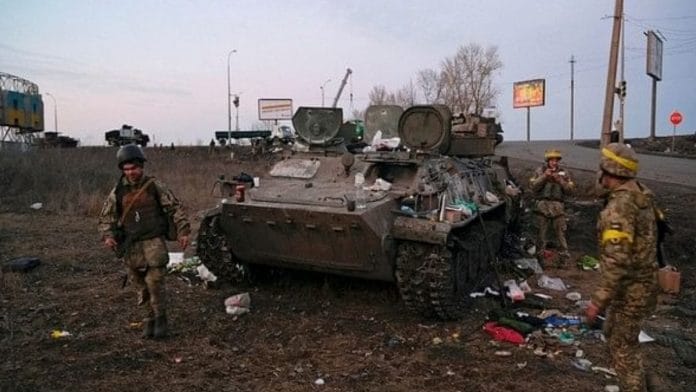New Delhi: The Russian cyber information warfare, shadowing the ongoing Ukraine invasion, has used disinformation as a tool to manipulate news, videos and social media content. But how are they doing it?
Through cyber attacks on Ukrainian government websites and banks, hacking high-profile individuals’ social media accounts, and using pro-Russian media to share unverified information of Ukrainians trying to kill Russian speakers around border areas.
Heads turned towards Facebook, Twitter and YouTube this week as the US-based tech giants announced a ban on ads for pro-Russian websites. Hackers associated with the Russia-linked ‘Ghostwriter’ group were also banned but the damage was already done online.
Ghostwriter had earlier hacked accounts of several east Ukrainian politicians, denigrating NATO and pushing anti-west Russian propaganda.
However, this clampdown didn’t promise safety to the Ukrainian cyberspace for anyone following the online information warfare. These actions stood as a testimony for the world that governments are actively pushing propaganda that could justify a country’s military activities on the ground.
US President Joe Biden was reportedly presented with several cyberattack options a few days ago to disrupt Russia’s on-ground invasion as retaliatory measures; some believe that this will be the way forward for allies too.
As a strategy, this phenomenon dates back to World War 1 when Western governments made “committees of public information” to push manipulated content in their favour, shaping a specific public view of the “enemy”. Officials in this bureau, back then, monitored public conversations and exercised enough power to build an information grid favouring any military moves of the US government.
In a similar move, the Bolshevik party in 1923 approved the establishment of the Disinformation Bureau — functions of which were the same except that the target was “pro-western” forces. All of them came under the larger term “dezinformatsiya”, which was allegedly coined by the Russians.
The only difference between strategies then and now is the sophisticated use of the internet and technology.
Also read: India expects West sanctions on Russia to impact key sectors, defence, engg could take big hit
Russia’s first visible onslaught on Ukrainian cyberspace
In February 2014, when the pro-Russian former Ukrainian President Viktor Yanukovych was overthrown, Vladimir Putin openly revealed details of how he helped flee his ally from violent protests in the country.
The then German Chancellor Angela Merkel pointed out how elections in a democratic nation should be under its own law, a hint to the world that Putin had crossed lines in providing overwhelming support to a leader who was removed in the country’s own parliament.
Almost all of Putin’s statements after this were directed towards the “pro-Western government in Kyiv for using force against the rebels [in Ukraine’s east] rather than conducting talks”, said a BBC report. This was also a time when he blamed the US for all the turbulence in the world, whether it was Ukraine or the Middle East.
The narrative was reportedly pushed by the Russian government through information operations right before the Crimean invasion in 2014.
News reports claimed that Russia engaged in cyber warfare that included “distributing misinformation” in Ukraine. Back then, social media giants like Facebook seemingly had no means to crack down on any such information that was disseminated by pro-Russian media outlets.
Hence, these narratives existed freely online, creating confusion within Ukrainian territories.
What happened in the US six years ago?
After a full-scale forensic Federal Bureau of Investigation (FBI) probe in the US, known as The Mueller Report, in 2019 caught alleged links between Russia and former President Donald Trump’s campaign, accusations instantly flew towards Russia to have influenced the US presidential polls in 2016.
Since then, information operations have relentlessly sought to subvert Western nations’ narrative that accused Russia of annexing democratic former Soviet territories.
Facebook was freely used as a platform for disinformation, although the social media giant has denied being directly involved. Organisations like Cambridge Analytica learnt how to use these channels, using data of individual Facebook users and allowing the Trump campaign to build voter profiles.
Also read: Hollywood star Sean Penn leaves Ukraine on foot, ‘walks miles’ to reach Polish border
Ukraine’s careful social media approach
In the past few weeks, amid disinformation on platforms in favour of Russia’s military operation, some Ukrainian lawmakers including President Volodymyr Zelensky, started building a parallel “heroic” narrative.
This was when Ukraine was overpowered on land and Russian social media was filled with provocative posts that claimed “Kyiv’s desire to kill Russian speakers”.
Cabinet ministers came out, they began vlogging and sharing posts of Zelensky joining the army that were later deemed false. As a result, some say that the Ukrainians aced the online social media battle against Russia.
(Edited by Amit Upadhyaya)
Also read: ‘If you are Black, you should walk,’ rampant racism at Ukraine border for droves fleeing






